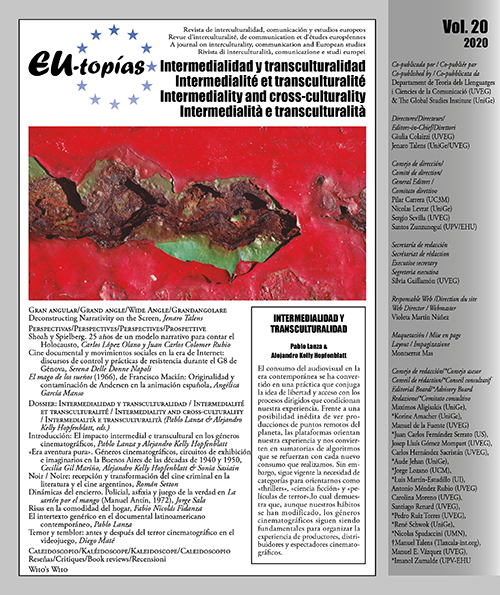«It was pure adventure». Film genres, exhibition circuits and imaginaries in 1940’s and 1950’s Buenos Aires
DOI:
https://doi.org/10.7203/eutopias.20.19389Keywords:
Movie audiences, classical cinema, film genres, modernity, social imaginaries. Abstract
Abstract
The incorporation of oral history methodology into film and entertainment historiography has brought more complex and original perspectives. Among them, inquiries on taste and consumption are leading to a reformulation of notions such as popularity and success and to new frameworks to study the relationship between film and society. This paper delves into these subjects by focusing on the role played by genre narratives in classical cinema. We take into account Rick Altman’s proposal about the dynamic character of genres and Annette Kuhn’s works on cultural memory in order to look into Buenos Aires’ film spectators in the 1940s and 1950s. By taking into consideration a group of interviews with senior citizens, we study film genres’ impact on their consumer habits and their relations with their environment.
 Downloads
Downloads
 References
References
Altman, Rick. Los géneros cinematográficos. Barcelona: Paidós, 2000.
Appadurai, Arjum. Modernity at large. Cultural dimensions of globalization. Minneapolis: University of Minnesota Press, 1991.
Cozarinsky, Edgardo. Palacios plebeyos. Buenos Aires: Sudamericana, 2006.
Dibeltulo Silvia. «Reconstructing historical film genre consumption in post-war Italy», ponencia presentada en el Webinar Film Audience Movements and Migrations: Across Borders and Screens, Oxford, Septiembre 2020.
Giddens, Anthony. Las consecuencias de la modernidad. Madrid: Alianza, 1990.
Gil Mariño, Cecilia. El mercado del deseo: Tango, cine y cultura de masas en la Argentina de los ‘30. Buenos Aires: Teseo, 2015.
Hansen, Miriam. «The Mass Production of the Senses: Classical Cinema as Vernacular Modernism». Modernism/Modernity, 6(2), 1999, pp. 59-77.
Jarvinen, Lisa. The Rise of Spanish-Language Filmmaking: Out from Hollywood’s Shadow, 1929-1939. New Brunswick and London: Rutgers University Press, 2012.
Kuhn, Annette. «Heterotopia, heterocronia: place and time in cinema memory». London, Screen 45; 2, Summer, 2004, pp. 106- 114.
— «Memories of cinemagoing and film experience: An introduction». Memory Studies, 10 (1), 2017, pp. 3-16.
Maltby, Richard. «On the Prospect of Writing Cinema History from Below». Tidjschrift voor mediageschiedenis, 9 (2), 2006, pp. 74-96.
Maltby, Richard; Biltereyst, Daniël, and Meers, Philippe. Explorations in New Cinema History: Approaches and Case Studies. Routledge, 2011.
Mittell, Jason. Genre and Television. From Cop Shows to Cartoons in American Culture. London and New York: Routledge, 2004.
Stokes, Melvyn and Jones, Matthew. «Windows on the World: Memories of European Cinema in 1960s Britain». Memory Studies, 10 (1), 2017, pp. 78-90.
Ercole, Pierluigi; Treveri Gennari, Daniela, and O’Rawe, Catherine. «Mapping Cinema Memories: Emotional Geographies of Cinemagoing in Rome in the 1950s». Memory Studies, 10 (1), 2017, pp. 63-77.
Fuentes
Entrevistas
Clauso, Nilda. Entrevista individual, 11 de octubre de 2017.
Domínguez Neira, Graciela. Entrevista individual, 27 de diciembre de 2019.
García, Coca. Entrevista individual, 20 de enero de 2020
Leguizamón, Jorge. Entrevista individual, 13 de enero de 2020.
Marchetti, Élida. Entrevistas realizada por Daniela Merlano en 2009 en el marco del curso de Historia de los medios, de la Universidad Nacional de Quilmes, cátedra Daniel Dabenes.
Portas, Juan Carlos. Entrevista individual, 20 de octubre de 2018.
Rodríguez, Alicia. Entrevista individual, 17 de diciembre de 2019.
Simone, María. Entrevista individual, 25 de enero de 2018.
Telias, Mario. Entrevista individual, 13 de enero de 2020
Vila, Manuel. Entrevista individual, 28 de agosto de 2018..
Publicaciones periódicas
Claridad, noviembre de 1933 (149) n° 271, s/d.
Heraldo del Cinematografista, número extraordinario, julio de 1942: s/d
Film, 25 de diciembre de 1941, n° 1337, s/d.
La Nación, agosto de 1944, por Biyina Klappenbach. Carpeta de recortes, Archivo Museo del Cine Pablo Ducrós Hicken
Downloads
Published
How to Cite
-
Abstract434
-
PDF (Español)225
Issue
Section
License
![]()
The authors conserve the copyright. All content published in EU-topías. Journal of interculturality, Communication, and European Studies are subject to the license Creative Commons Attribution-NonCommercial-ShareAlike 4.0 license. The full text of the license can be found at <http://creativecommons.org/licenses/by-nc-sa/4.0>
They may be copied, used, disseminated, transmitted and publicly displayed, provided that:
- The authorship and original source of the publication is cited (journal, publisher and URL of the work).
- They are not used for commercial purposes.
- The existence and specifications of this license of use are mentioned.
It is the responsibility of the authors to obtain the necessary permissions for images that are subject to copyright.



